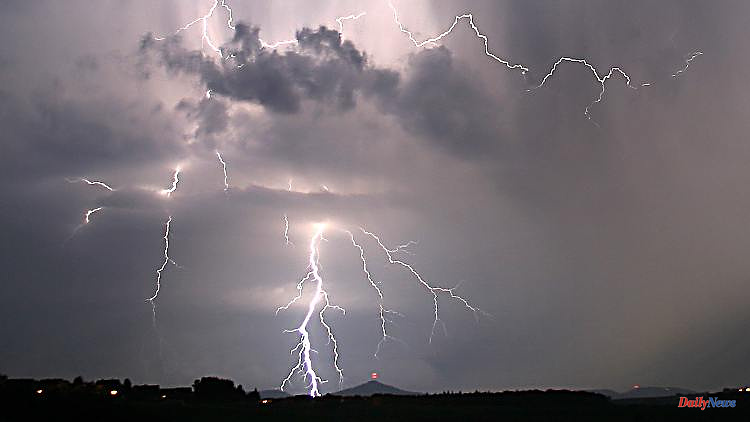Hot summer days often have side effects: violent thunderstorms with lightning and thunder. How do you behave if you get caught in one and are outdoors with no protective houses nearby?
Caught! Anyone who has not taken the first dark clouds and weather forecast seriously and is surprised by a thunderstorm on an excursion in the open field often has few options for sheltering. And it is better to keep your distance from many supposed shelters. A fact check, where you are most sure:
Claim: I should stay away from power poles.
Rating: That's right.
Facts: Lightning is most likely to hit high points that are prominent in the terrain - for example masts. The German Weather Service (DWD) therefore advises moving as far away as possible from all tall objects if you cannot seek shelter in a building during a thunderstorm - for example from observation towers and individual trees.
Claim: You should look for the lowest possible point in the terrain.
Rating: That's true, but you have to avoid the gorge and the river bed.
Facts: "One should make oneself as small as possible so as not to be the highest elevation in the area," explains DWD meteorologist Sebastian Schappert. The best thing to do is to look for a sink or hollow. "On the other hand, you can be in danger if you go into a gorge or a dried-up river bed in search of the deepest point, then enormous amounts of precipitation come down, collect somewhere and rush through there as a tidal wave," says Schappert. "So you have to be careful not to make yourself small at a point where there is a risk of flooding."
So how's it going right?
You look for a sink in open space. "Ideally, you have an insulating base," says Schappert. "Well, if you have shoes on, that's good. If you have a backpack with you and put it under your feet, that's even better. Because if lightning strikes nearby, the tension can spread to the person."
And you should squat down - with your feet close together so that you have a low step tension. In this way, you also reduce possible consequences for your own health, such as heart problems, in the event of a nearby lightning strike. Incidentally, this is the reason why entire herds of cows can die in the pasture in the event of a lightning strike - they have quite a large step voltage. Extra tip: "Ideally, you also protect your neck and head from hail," adds Schappert.
Claim: Umbrellas should be closed.
Rating: That's right.
Facts: "It's better to fold up the umbrella and pack it away," says meteorologist Schappert. It's like an extension of the body in a situation where you should make yourself as small as possible. Of course, the location matters here: in the city between skyscrapers, an umbrella is of course less of a risk than in the open field.
Claim: You should park your bike and motorbike at a distance.
Rating: That's right.
Facts: Schappert recommends that if you have to seek shelter outdoors in the said hollow, you should park metal objects such as bicycles and motorbikes at a distance. Because if lightning strikes the wheel, it can possibly spread further across the earth.
Claim: It is better to seek shelter individually in the open field.
Evaluation: Correct, but not always feasible.
Facts: "In the event of a lightning strike, voltage can flash over in the immediate vicinity. So this tip is about not getting the other ones if it does," explains Schappert. In this respect, it makes sense to squat down in a hollow at a distance. "But that's not really feasible with small children or dogs."
Claim: It is safer in a forest than in a field.
Rating: It depends on the circumstances.
Facts: "Both - neither in the open field nor in the forest - is not optimal," says Schappert. Several factors play a role in this. "It's certainly uncomfortable outdoors when it's hail or raining very hard. Then you'd probably prefer to be in the forest, because the trees keep something from it," says the meteorologist. "But even in the forest you should look for a depression or younger trees that are even smaller than the trees in the area." So the usual rule applies here: keep your distance from the tallest objects in the area as much as possible.
However, you can also be more at risk in the forest than in the open field, for example if you have to reckon with hurricane gusts. They can knock down trees. Another factor: when lightning strikes a tree, it can literally explode. The flying debris can injure people.
If at all possible, you should try not to be in nature at all during a thunderstorm and look for a building where you can find shelter.
Assertion: You should look for beeches, you have to give way to oaks.
Evaluation: The well-known saying is not true.
Facts: All trees can be struck by lightning. But there is an explanation for this old folk wisdom, which is based on observations that have been handed down.
There is almost never a visible sign of a lightning strike on the bark of beeches, according to a page by forester and specialist book author Peter Wohlleben. The reason: its bark is smooth and rainwater runs down it easily. In the event of a lightning strike, the current is conducted through the water film into the ground without damaging the trunk.
It is different with the rough bark of the oak. In a nutshell: Here, when lightning strikes, the heat evaporates the water in the outer part of the trunk, causing it to burst open.
Claim: You are only in danger when the thunderstorm is directly overhead.
Evaluation: This assumption may be life-threatening.
Facts: In exceptional cases, lightning can travel long distances. Schappert names such a case as particularly violent thunderstorms with high clouds and strong up and down winds.
Therefore, the meteorologist advises not only to seek shelter when you are directly under thunderclouds, but also when clouds are approaching and receding. In such strong thunderstorms, lightning strikes "with good power, almost out of the blue," says Schappert. "But that doesn't mean that the probability of being struck by lightning is particularly high. It's individual lightning bolts that occur every now and then."
Incidentally, this rule of thumb helps when estimating the distance of a thunderstorm: If three seconds elapse between visible lightning and thunder, the thunderstorm is less than one kilometer away.
Claim: A car is a safe haven.
Rating: That is only partly true.
Facts: A normal car forms what is known as a Faraday cage, which directs the electrical discharge around the occupants and thus protects them. Even in a closed convertible there is no increased risk of impact. However, the automobile club advises not to touch any metal parts in the vehicle interior that are connected to the body after an impact. But not all cars have these anyway. Since plastic linings are common today, this shouldn't be a big problem, according to the car experts.
Another danger: a lightning strike can blind the occupants and easily damage the car. Therefore, the expert advice if you have to seek shelter in the car is: It is better not to park it in an exposed location such as on a hill, so that the risk of a lightning strike is reduced. Close the windows and sunroof and retract all aerials as far as possible.












